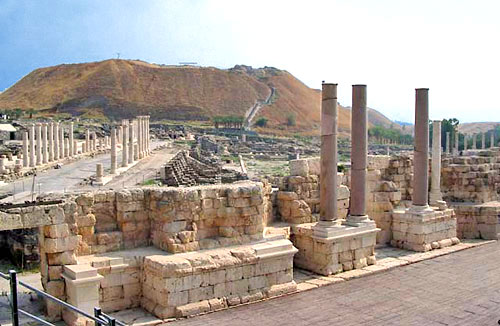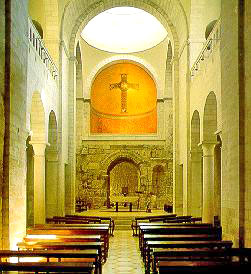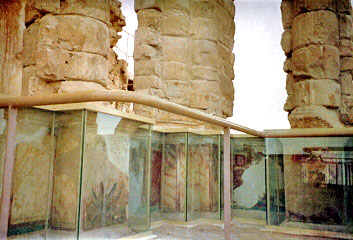MERRY CHRISTMAS and a very Happy and Prosperous NEW YEAR to all our readers world wide.
We still need $120 to meet our deficit by the first. If you can afford it, please donate off to the right of this blog. Help us keep going until we can build our business to meet that deficit ourselves. Thank you and God Bless you in a very special way today. We are very grateful for all who have aided us so far in so many ways.
Vatic Note: I have to say that this below is excellent background material and very relevant to future parts to this subject and is well worth the time and effort to read and digest. Its truly foundational material. I spent 50 years researching the original Church of Jesus Christ and learned volumes about the structure of the original church and it was in many ways, much different, and in other ways very similar to the Jewish faith.
This below truly does reflect much of what I found. The essenes were a big part of the movement away from the center of foreign occupation of Israel at the time. They did not like the direction their faith was going in with all the pagan influences that were prevalent at the time.
The Greeks had been there a lot longer than the Romans, and the romans left a lot of their paganism, so between the two Judaeism was evolving to a point that the essenes were frustrated and wanted to get back to their faith as it used to be.
That is why they moved to the Dead sea and that is where they stored and wrote records of their beliefs and history. That resulted in the Dead Sea scrolls that we know about today. Anyway, this goes into much more detail and is highly educational, so please take the time to read and digest what you have read.
The Dragon Society Real History, Dragon Philosophy and The Importance of Royal Bloodlines, Part 2 of 6 - The Code of a Revolution
http://web.archive.org/web/20031214194738/http:/www.thedragonsociety.com/TheCodeofarevolution.html
http://www.bibliotecapleyades.net/sociopolitica/sociopol_brotherhoodsnake06.htm#Monarchy
By Tracy R. Twyman, Bibliotecapleyades,
The Background
Many Christians in Europe and North America today feel that the stories in the New Testament should not perhaps be taken as literally as they were a few generations ago. Of course Darwin’s theory of evolution has contributed much towards this.
Also, in industrial societies, we do not feel such a need to pray to God for harvests, even though we may appeal to him for good weather for our holidays as a kind of insurance policy. There are, of course, those who take every word in the New Testament literally, and their beliefs have to be respected.
However, we have to bear in mind that Palestine at the time of Jesus Christ was a country in chaos. Three thousand Jewish rebels were crucified under the occupying power of the Romans after they had assumed direct rule of the Jews in 6AD.
Pontius Pilate was a cruel and corrupt ruler who compounded the atrocities committed by his predecessors. It is therefore surprising that there were no openly anti-Roman writings in the Bible to relate these circumstances. Not even such incidents as the burning of Rome by Nero were mentioned.

Beit She’an Roman Theatre, Israel
There was a bewildering array of active Jewish sects and sub-sects at the time. Jesus Christ was a Jew, and there is evidence that his sympathies were with the Jewish uprisings organized by such groups. According to The Dead Sea Scrolls Deception, Jesus Christ seemed to have connections with most of them. It is difficult to differentiate among the various groups.
There were the Pharisees who, despite what is said in the Bible, were anti-Roman, although rather more passively so than other sects. The original Greek version of the Bible refers to Jesus Christ as a Nazarene.
This was later wrongly interpreted to mean that he came from Nazareth. It is believed that the town of Nazareth did not exist at the time of Christ’s birth as there is no contemporary mention of it.
The sect, the Nazarines or Nazarites, were certainly in existence at the time of Christ, and Christ’s brother, James, and John the Baptist were both Nazarites.
The modern Arabic word Nasrini means Christian, and derives from the Hebrew Nazrim, a plural noun that comes from the term Nazrie-ha-Brit which means ‘Keeper of the Covenant’, a rank of the Essenes Community at Qumran on the Dead Sea. The Nazorites were associated with the Community of the Essenes in the time of the Gospels. The Essenes were an austere mystical sect whose influence at the time is underestimated. The Nazarites were an important sub-sect of the Essenes.
It is highly probable that if Christ did not actually belong to the community known as the Essenes, he was well-versed in their beliefs and sympathized with them. The Essenes believed strongly in the coming of the Messiah, descended from the line of David.
There was also a group called the Zealots. They were not an independent sect, rather a group whose members originated from other sects, and constituted the ‘strong-arm’ of the movement against the Romans.
Their activities would today be termed ‘terrorist’ and the uprising of the whole of Judea against the Romans in 66 AD was the result of their activities. Although the Jews were massacred by the Romans after this revolt, the activities of the Zealots continued unabated for another century after Jesus Christ’s death.

The Church of Ecce Homo where Pilate allegedly judged Jesus
Even if Jesus Christ had not been a Zealot himself, he was crucified as one. The two men who were crucified with him certainly were Zealots. Jesus Christ embarrasses the church by being reported as saying that he has come not to "bring peace but a sword". He asks his disciples to purchase swords [Luke 22:36], and checks that they have swords after the Passover meal [Luke 22:38].
According to the fourth Gospel, Simon Peter is carrying a sword when Jesus is arrested. In the context of the day, these are surely the descriptions of a leader who is prepared for and willing to take part in violence. Certainly Christ was executed by the Romans in the way that they reserved for revolutionaries.
Jesus Christ had no intention of forming a new religion. The idea that the Messiah was regarded as divine would have been preposterous to the Jews. The Greek word for Messiah is ‘Christ’ or ‘Christos’, and means anointed one, or king.
When David became king, he was also a ‘Messiah’ or ‘Christ’. When Jesus was born, he was also seen as being the Messiah because of his Davidic pedigree. The Jews felt that this new-born king would be the one who would deliver them from the Romans.

Herod’s Northern Palace with 2000 year old frescoes
It is evident that the stories in the New Testament are told in an allegorical way; in a code that would be understood by some of the Jews and not by their Roman rulers. Words that are used seem strangely unrelated to their actual meanings, until, perhaps, we consider how certain terms have come into the English language.
We can say, for example, "He used to be on the board, but now he is in the Cabinet." This, of course, does not mean, "He used to be on a piece of wood, but now he is in the cupboard."
These words and phrases (in Hebrew pershar in the singular, persharim in the plural) had the same meaning each time they were used. Additionally each time the meaning was required, the persharim were used.
Before looking at some of the more familiar stories from the Bible, here are some of the words used in the New Testament and the explanation of what they really mean. The following explanations are taken from the Persharim, the Manual of Discipline, the Community Rule and the Angelic Liturgy as quoted in The Bloodline of the Holy Grail.
for those with ears to hear
this was the signal that a statement that there would follow a message that could be interpreted by those who knew the code
Babylon
Rome
the word of God, the word
Jesus Christ
the lion
the Roman Emperor
the poor
those who had been initiated into the higher ranks of the Community and had therefore had to give up their worldly wealth
the many
the head of the celibate Community
the crowd
a designation of the regional Tetrarch (governor)
the multitude
the governing council
the children
the novices within the community
the Way
the doctrine of the Community
the Children of Light
those who followed the doctrines of "the Way"
leper
a person who has not yet been initiated into the higher Community
the blind
those who did not follow the doctrine of "the Way"
the Power, the Kingdom, the Glory
the Priest, King and Prophet of the Community
The Loaves and the Fishes
The story of the loaves and fishes is an example of a parable. As an example of how the coding was used to inform "those with ears to hear" let’s look at one of the more familiar stories from the Bible, and see how the code was used.
Gentiles who wanted to be baptized in the Judaic tradition were referred to as "fishes". They were hauled out of the water into boats by "fishermen" to be blessed by the "fishers" who were the priests. Similarly, the Levite officials of the Sanctuary were known as "loaves".
In the ordination rite, the Levite priests would serve seven loaves of bread to the priests and five loaves and two fishes to the celibates. The Gentiles were allowed to receive baptism only as "fishes" whereas only Jews could become "loaves".
At these ceremonies the "fishermen" would take their boats out into the water, and the Gentile fishes, who were to be baptized, would walk out into the water. When this had taken place, the priest "fishers" would walk out into the water along jetties, and thus "walking on water" to the boats.
As Jesus had been born into the house of Judah, and was therefore not a Levite, he was not entitled to act as a baptismal priest, but he chose to disregard this convention, and "walked on the sea" to the disciples’ boats.
One of the main aims of Jesus Christ’s philosophy was to bring the "unclean" Gentiles together with the Jews, and furthermore to let them take part in what had been reserved for the Jewish priesthood.
There was a group of uncircumcised Gentiles known as the "Five Thousand", and Jesus granted the "multitude" (in other words, their governing body) the serving of five loaves and two fishes that were otherwise the reserve of the Jewish priesthood candidates.
None of this detracts from any skills Jesus Christ may have had as a healer. However, it was not a healer that was predicted to arrive as the Messiah. What differentiated Jesus from the others was that, despite the feelings of such groups as the Pharisees, he extended his medical expertise to the "unworthy" and "unclean" Gentiles, thus illustrating his ideal of a united people against the authority of the Romans.
Bibliography
The article is reproduced in accordance with Section 107 of title 17 of the Copyright Law of the United States relating to fair-use and is for the purposes of criticism, comment, news reporting, teaching, scholarship, and research.

No comments:
Post a Comment